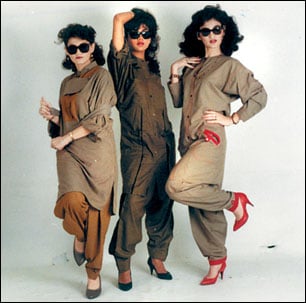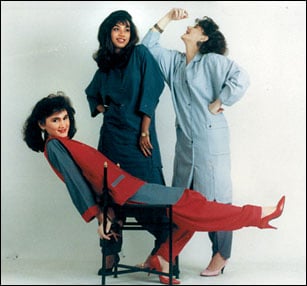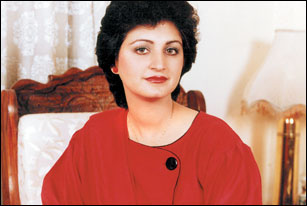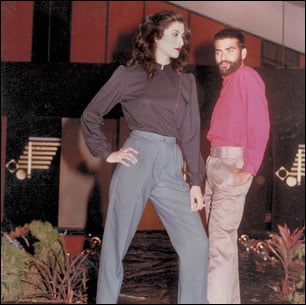|
|
| |
instep
profile
Teejay still has designs on fashion
More than three decades after he revolutionized the shalwar
kameez, Tanveer Jamshed, better known as Teejay, is being recognized
for the milestones in his career. He was awarded the Sitara-i-Imtiaz
by the President of Pakistan earlier this year and recently given
a Lifetime Achievement in Fashion Award at the LSAs in Malaysia.
These accolades, Teejay says, have rekindled his passion for fashion
and he is once again aiming to achieve the impossible.
By Aamna
Haider Isani
|
| |
It
is impossible not to think of Teejays and Tanhaiyan in the same flash
of memory. It was the PTV play in which Marina Khan embodied the essence
of being fashionable in a shalwar kameez, for the first time in Pakistan's
history. It wasn't long before our entire generation of teenagers
followed the universal dress code. Dressing up became all about collars
and boat shaped necklines, empire sleeves and bottom hugging, tight
slit-free shirts. It was an explosion of colour, from the plastic
baubles in our ears to colour combinations in our clothes and the
shiny court shoes on our feet. As outdated as it may sound today,
those trends had reverence back then. And they were initiated by one
man, Tanveer Jamshed, who had managed to break the taboo and make
fashion fashionable for the masses.
|
 |
| |
It
was a time in the seventies when there were 'good' girls and then
'fashionable' girls," Teejay remembers. "The fashionable
ones didn't get married, so big was the taboo associated with the
word."
But he managed to break the taboo and revolutionize fashion in an
unprecedented way. The only thing that went to his advantage was his
upbringing. His forefathers were die hard army men but back then the
military was a lot more gentile than it became after General Zia's
11 years of rigorous brain washing. Teejay grew up in an elite environment
that included Karachi Grammar Schooling and evenings at the Sindh
Club. His creativity came from a 'genetic disorder', he says. |
| |
"Creativity
was the key word and I still believe that either you have it or you
don't. It can't be enforced on anyone. I was exposed to broadminded
people. My father allowed me to be liberated. He was well dressed
and fashionable and that strength allowed me to tap what I needed.
I belonged to high society and so had no desire to climb the social
ladder. That's why I could so easily take fashion to the masses."
That's exactly what he did, though he admits it wasn't simple. In
1973, Teejay designed Roohi Bano's wardrobe for Shireen Khan's Kiran
Kahani and then for Zer Zabar Pesh and Uncle Urfi amongst the 147
plays that were to come. He had bravely started dabbling in creativity,
though there was no field to play in. He organized his first fashion
show in college and everything he did was an invention, from fashion
models, photographers and then shoots.
|
 |
| |
He
wanted to play the game as it was being played in the rest of the
world. He wanted to open shops and advertise. But at that time there
were no services to market fashion.
Teejay took the plunge, opening shops that were painted black with
psychedelic posters on the walls. Teejay came to be known as "that
crazy man". He went for colour spreads in print. For Teejay,
creating TV wardrobes became the natural form of marketing fashion
and Tanhaiyan did for him what serials like Sex and the City do for
fashion today. Teejay was progressive with his idea to take fashion
to the masses. This is what street wear does in the West and today
brands like Khaadi, Crossroads and Generation are carrying on from
where Teejays left off. |
| |
"We
redesigned the shalwar kameez. It went from awami to the Sindh Club,"
Teejay states proudly. "We created a demand for it in high society.
These were people who would rather go shopping in their night suits
than shalwar kameez. The West was their trapping; it was 'babu' culture."
Teejay is fond of the history of clothing and the role his label played
in reinventing the shalwar kameez.
"The British left us with shame for the shalwar kameez. I took
that out. We proved that it is not a uniform. We remodeled it and
added colours to menswear. It went from the basic grey shades to black
and bright blue. Shalwar kameez became exciting. Then it became explosive.
The urban-rural divide was erased. I've always said that the shalwar
kameez is the Urdu language of fashion. We helped that subconscious
integration." |
 |
| |
But
that integration saw a dilution with time. "It hit the overkill,"
Teejay states.
"General Zia enforced the shalwar kameez on everyone. When you
impose something, it results in eventual rejection and when Zia went,
people took their trousers out and dispensed with the national dress.
My idea of a shalwar kameez was not a costume or a permanent uniform.
It was a part of the wardrobe. But it had to be pro choice, which
it has become today. Now youngsters wear kurtas as easily as they
wear tee shirts. I'm very glad to see it like this." |
| |
Though
the shalwar kameez survived the test of time, fashion, as Teejay sees
it today, didn't evolve the way he would have chosen it to. Having
seen the industry grow, literally from scratch, he admits to a sense
of disturbance when he observes its growth.
"We have Indianized our look. That's what bridals are all about.
It's Indian invasion. Bridals have become so big because they demand
very little energy and it gives a lot of rich suckers a way to spend
and exhibit their wealth," he says with disdain for the industry
that has been built around a single event – the shaadi. Teejay
looks at bridals as the easy way to make money for designers who do
not have the wherewithal to cater to the Pakistani populace at large.
|
 |
| |
| "Today
I feel that designers are too engrossed in ego trips. Fashion has
become who you are dressing up and where you get invited. Designers
should have gone into designing economical lines that take fashion
to the masses. They need to put in more time and more hard work. The
challenge is to make clothes that retail at 999 rupees. It's a huge
market to be tapped." |
| |
Teejay
strongly feels that fashion today has hit a dead end.
"Have today's designers managed to change the look of the country?
No," he scoffs. "Designers have the huge responsibility
to erase boundaries. Not create them. What they are doing is a massive
PR job.
Fashion in Pakistan concentrates on high society, fraternities. 'You
scratch my back, I scratch yours'. Fashion has to become people friendly,
not pseudo elite. It needs to change the way the nation looks, not
a certain group of people. Fashion is actually disturbing the social
mindset today." |
 |
| |
| Teejay's
answer to all of this is a program he is planning for television.
He wants to invite 13 big names in fashion and challenge them into
designing a 12 piece ready to wear collection that retails at no more
than 1500 rupees per piece. He says he's doing it to encourage designers
to step out of the box. |
| |
"My
show will be ground breaking. I'm going to create a seven piece orchestra
for this show and have already found someone who plays the cello in
Pakistan. Orchestra is my second passion. There will be a new 'singer
of the day' each week and I will hand him over to a good composer.
Perhaps we'll even seat the audience and serve them a candle lit gourmet
meal, and fashion will definitely be on the menu," he says with
a smile. "The Lux Style Awards have rekindled my passion. I feel
I have to step back into the game."
All of a sudden Teejay admits to feeling an overwhelming urge to whip
up a retail environment for Pakistani fashion. It is the need of the
hour and he hopes his show will challenge designers into it. He also
emphasizes on the moral thread that seems to be missing from fashion
these days. Fashion, he says, is suffering under overpricing and bad
quality. |
 |
| |
|
"Designers are part of nation building,"
he says emotionally. "But are they contributing to nation building?
No. It's sad. They're all great kids and I love them but they're
locked in. Their growth is stunted. They have the support but they
need to be willing. There isn't a single affordable working women's
wardrobe in the market and affordable means 999 rupees not 9999.
They are a great bunch of kids but this industry needs leaders to
step forward and give direction."
With almost forty years of labour behind him, TJ feels he is ready
to take up the challenge of guiding the industry. His children are
already involved with the business – Ali is heading the management
of all 14 Teejays stores across Pakistan and his daughter Feeha
is involved in the designing. She will be opening her first Teejays
womenswear store in Clifton very soon. With that well in control,
TJ says he has designs on a lot more.
"The World Trade Order is going to bring in a flood of merchandising,"
he says. "They will wash out Pakistan's fashion industry. We've
lost the markets of children's clothing, shoes, accessories. It's
gone. The act is almost over. I want to help bring it back. I want
to start a fashion school. I have the land; I'm planning a state
of the art fashion school in Karachi. Fashion schools need to breed
creativity. They need to be a place that inspires, not where the
exterior offers no energy. It needs to be conducive to craziness.
There needs to be music, madness. There's so much to do here."
With this fresh wave of energy, it sounds like Teejay is going to
be back in business very soon. He did it in the seventies when he
created an industry out of nothing and he's back with another vision.
Fashion is no longer taboo in Pakistan but the cut throat and competitive
nature of the industry makes it just as rugged and aggressive to
tackle. He's looking to put moral fibre back in clothes, and use
pricing to cut across class boundaries instead of making a greater
distinction between the haves and have nots.
It's an uphill task, but far easier today than when Teejay blazed
a trail back in the '80s. Chances are he'll do it again.
--Teejay
and Feeha on the LSA red carpet photographed by Faisal Farooqui
|
| |
|

